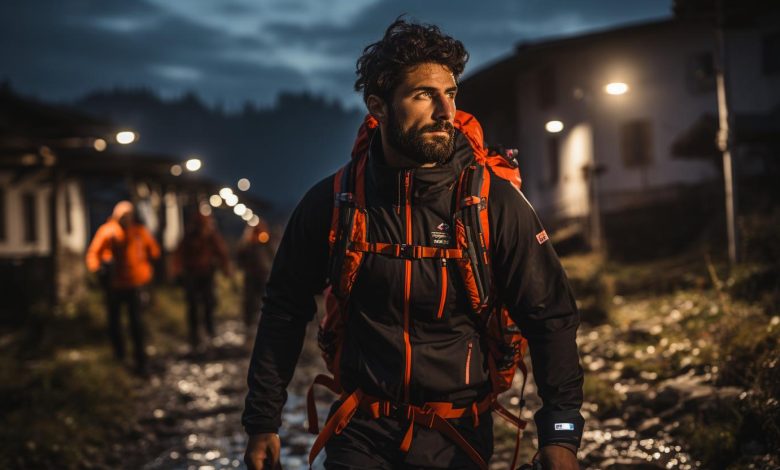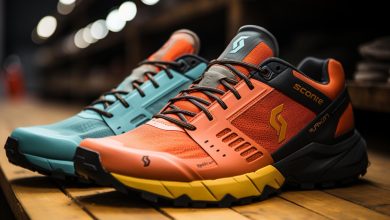Trail Running Accessories: Gaiters, Headlamps, and Trekking Poles

So, you think you’re ready to hit the trails, huh? Well, before you lace up those running shoes and take off on your epic adventure, let’s talk about some essential accessories that will make your trail running experience even better.
Gaiters, headlamps, and trekking poles may not be the first things that come to mind when you think of running gear, but trust me, these little wonders can make all the difference.
Let’s dive in and discover how these trail-running must-haves can take your outdoor escapades to new heights.
Benefits of Gaiters for Trail Running

Gaiters are great for keeping debris out of your shoes while trail running. They are designed to fit over the top of your shoes and extend up your lower leg, providing an extra layer of protection against rocks, dirt, sand, and other trail hazards. The primary advantage of wearing gaiters is that they prevent these unwanted particles from entering your shoes, which not only keeps you comfortable but also reduces the risk of blisters caused by friction between your feet and the debris.
One major pro of wearing gaiters in trail running is their ability to keep your feet dry. Gaiters act as a barrier against water, preventing it from seeping into your shoes during creek crossings or wet conditions. This can be particularly beneficial in colder weather when wet feet can lead to discomfort and even hypothermia.
However, there are some cons associated with wearing gaiters as well. One potential drawback is that they can add extra weight to your gear, which may impact your speed and agility on the trails. Additionally, if not properly fitted or secured, gaiters may cause discomfort or chafing around the ankle area.
To prevent blisters with gaiters, it’s important to choose ones that fit snugly around your ankles without being too tight. Make sure they have a secure attachment system that won’t come loose during intense runs. Also, consider using moisture-wicking socks to further reduce friction and moisture build-up inside the shoe-gaiter combination.
Choosing the Right Headlamp for Night Runs

To ensure you have a safe and enjoyable night run, it’s important to choose the right headlamp. When it comes to headlamp brightness levels, there are a few factors to consider.
The brightness of a headlamp is usually measured in lumens, with higher numbers indicating brighter lights. For trail running at night, it is recommended to choose a headlamp with at least 200 lumens for sufficient visibility on uneven terrain.
Another crucial factor to look into is the headlamp battery life. You don’t want your headlamp dying on you while you’re out on the trail. The battery life of a headlamp can vary depending on the power output and settings used. It is advisable to opt for a headlamp that offers longer battery life so that you can rely on it throughout your entire run.
When choosing a headlamp, also consider its weight and comfort level. A lightweight and comfortable headlamp will be less likely to cause discomfort or distract you during your run.
Advantages of Using Trekking Poles on the Trail

If you’re looking to enhance your hiking experience, using trekking poles on the trail can offer numerous benefits. Not only do they provide stability and support, but they also help reduce the impact on your joints and muscles. Here are three advantages of incorporating trekking poles into your hiking routine:
1. Improving Stability: Trekking poles act as additional points of contact with the ground, providing you with increased stability and balance while traversing uneven terrain. This extra support can prevent slips and falls, making your hike safer and more enjoyable.
2. Reducing Impact: As you hike, the repetitive motion of stepping can put strain on your knees, ankles, and hips. By using trekking poles to distribute some of your weight onto your arms, you can significantly reduce the impact on these joints. This not only decreases discomfort but also helps prevent long-term injuries.
3. Enhancing Endurance: When using trekking poles, you engage both your upper body and lower body muscles simultaneously. This results in a more efficient use of energy and an overall improvement in endurance. With each step, you propel yourself forward by pushing off with the poles, allowing you to hike for longer distances without feeling as fatigued.
By incorporating trekking poles into your hiking gear arsenal, you’ll experience improved stability, reduced impact on your joints, and enhanced endurance during your outdoor adventures.
Now that we’ve explored the benefits of using trekking poles, let’s delve into some tips for properly fitting and adjusting gaiters…
Tips for Properly Fitting and Adjusting Gaiters

Ensure that your gaiters are properly fitted and adjusted for maximum comfort and protection on the trail. Proper gaiter sizing is essential to prevent debris, dirt, and water from entering your shoes or boots while hiking or running. Ill-fitting gaiters can cause discomfort, hinder movement, and compromise their effectiveness.
To determine the correct size of gaiters for your footwear, measure the circumference around the calf at its widest point. Most gaiters come in different sizes based on calf measurements, so be sure to consult the manufacturer’s size chart before making a purchase. Additionally, consider the length of your gaiters to ensure they adequately cover your ankles and provide full protection.
When troubleshooting gaiter fit issues, start by adjusting the straps or buckles according to your comfort level. Make sure they are snug but not too tight as this may restrict blood circulation or cause discomfort during prolonged use. If you notice gaps between your shoes/boots and the bottom of the gaiters, try using a thicker pair of socks or tightening them further.
Remember that proper fitting and adjustment play a crucial role in preventing blisters, hotspots, insect bites, and scratches while out on the trail. By following these tips for properly fitting and adjusting your gaiters, you can enjoy a more comfortable and protected outdoor experience.
Essential Features to Consider When Buying Headlamps

When buying headlamps, it’s important to consider essential features such as brightness levels, battery life, and adjustable beam settings. Here are three key factors to keep in mind:
1. Brightness Levels: Look for a headlamp that offers different brightness settings to suit various conditions. Whether you’re running on a well-lit trail or navigating through dense forest at night, having the ability to adjust the brightness can greatly enhance your visibility and safety.
2. Battery Life: Consider how long the headlamp’s batteries will last on a single charge. Longer battery life means less frequent charging and more uninterrupted time spent on the trails. Opt for a headlamp with a longer runtime if you plan on embarking on longer runs or multi-day adventures.
3. Waterproof Rating: Trail running often exposes you to unpredictable weather conditions, so choosing a headlamp with a high waterproof rating is crucial. Look for models that are rated IPX7 or higher, as they can withstand heavy rain and even immersion in water up to a certain depth for a limited time.
Conclusion
Congratulations on finishing the article!
Now, you might be thinking, ‘Who needs gaiters, headlamps, and trekking poles for trail running?
Well, my friend, let me tell you this – only those who want to truly enjoy the experience!
Because who doesn’t love getting their shoes filled with dirt and debris?
And why bother seeing where you’re going when stumbling in the dark is so much more fun?
And forget about having extra support and stability on challenging terrains.
Yes, indeed, these accessories are absolutely unnecessary for an enjoyable trail running adventure.






